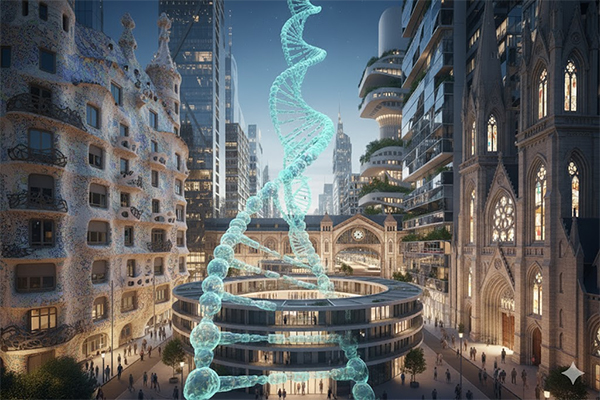Report on the Integration of Smart Building Automation for Sustainable Development
Executive Summary
The architectural and construction sectors are pivotal in achieving global sustainability targets, as buildings account for approximately 40% of global energy consumption and related carbon emissions. This report outlines the necessity for architects to integrate smart automation systems, such as KNX, to design energy-efficient, future-proof buildings. Such integration is critical for making substantial contributions to several United Nations Sustainable Development Goals (SDGs), including SDG 7 (Affordable and Clean Energy), SDG 9 (Industry, Innovation, and Infrastructure), SDG 11 (Sustainable Cities and Communities), and SDG 13 (Climate Action).
The Imperative for Energy Efficiency in the Built Environment
Addressing SDG 7 (Affordable and Clean Energy) and SDG 13 (Climate Action)
The significant energy footprint of the built environment presents an urgent challenge and a critical opportunity for climate action. The drive towards enhanced energy efficiency is propelled by several factors:
- Rising Energy Costs: Increasing operational costs for buildings necessitate more efficient energy management.
- Climate Change Mitigation: Reducing the carbon footprint of buildings is a direct and impactful measure to combat climate change, aligning with the objectives of SDG 13.
- Regulatory Compliance: Tightening international standards, such as the EU’s Energy Performance of Buildings Directive, mandate higher levels of energy performance.
By focusing on energy efficiency, the architectural sector can directly support the transition to cleaner energy systems as outlined in SDG 7.
The Architect’s Role in Fostering Sustainable Infrastructure (SDG 9)
Architects play a foundational role in a building’s lifecycle performance. Decisions made during the initial design phase regarding form, materials, and integrated systems have lasting impacts. The integration of smart automation systems represents a key innovation in developing the resilient and sustainable infrastructure central to SDG 9. This requires a forward-thinking approach where technology is embedded into the building’s core design rather than being an afterthought.
Strategies for Sustainable Building Design
Foundational Passive Design Strategies
Passive design remains the cornerstone of energy-efficient architecture. These strategies reduce a building’s intrinsic energy demand before any active systems are considered. Key principles include:
- Optimized site orientation to control solar gain.
- High-performance insulation and glazing to minimize thermal loss.
- Strategic layout and natural ventilation to reduce reliance on mechanical systems.
Developments such as the Bullitt Center in Seattle and the BedZED development in the UK serve as prominent examples of how passive techniques can drastically reduce energy requirements.
Active Energy Management with KNX Automation
Beyond passive measures, active energy management through automation systems like KNX is essential for optimizing performance. KNX is an open international standard for smart building automation that enables various subsystems to communicate and operate in an integrated, efficient manner. This directly contributes to SDG 12 (Responsible Consumption and Production) by minimizing resource waste.
KNX systems can manage:
- Lighting and HVAC: Adjusting levels automatically based on occupancy, time of day, and available daylight.
- Blinds and Shading: Dynamically controlling solar gain to reduce heating and cooling loads.
- Energy Management: Integrating smart metering, electric vehicle charging, and energy storage to reduce peak loads and optimize the use of renewable energy.
Case Studies: Implementing KNX for Sustainable Outcomes
The versatility and effectiveness of KNX in achieving sustainability goals are demonstrated in diverse projects worldwide, contributing to the development of Sustainable Cities and Communities (SDG 11).
- Dubai Expo 2020 Pavilions, UAE: These structures utilized KNX for advanced, human-centric lighting solutions, smart presence detectors, and sun-tracking controls to minimize energy consumption while enhancing visitor experience.
- Imperial Lexis Hotel, Kuala Lumpur, Malaysia: This award-winning smart building deploys KNX systems to deliver superior guest comfort while championing a highly energy-efficient model for hospitality design.
- The Crystal, London, UK: This landmark building integrates comprehensive KNX-based systems to automate and minimize energy use, supporting its net-zero operational goals and showcasing a model for sustainable urban architecture.
Fostering Collaboration and Innovation for Future-Proof Buildings
The Importance of an Integrated Design Process
Achieving optimal building performance requires a paradigm shift from traditional, linear design workflows to a more collaborative and integrated process. Early and continuous collaboration between architects, mechanical and electrical (M&E) engineers, and automation specialists is crucial. The use of Building Information Modelling (BIM) facilitates this process, allowing teams to simulate and optimize building performance before construction begins, thereby fostering the innovation central to SDG 9.
Future Outlook: AI, Automation, and Sustainability
The adoption of smart building technology is accelerating, with over 500 million KNX devices installed globally as of 2023. The future of sustainable design lies in the convergence of automation with emerging technologies like Artificial Intelligence (AI). This integration promises even greater efficiencies through predictive energy management and buildings that intelligently adapt to user needs and environmental conditions, further advancing progress towards the SDGs.
Conclusion: The Essential Role of Automation in Responsible Design
For architects, proficiency in smart automation systems is no longer a niche specialization but an essential component of responsible, high-performance design. Systems like KNX offer scalable, practical, and proven solutions to reduce energy consumption and emissions, making them indispensable tools in the effort to meet global climate and sustainability targets. As digitalization and sustainability converge, building automation is becoming a standard practice, fundamental to creating the resilient, efficient, and sustainable communities envisioned in the Sustainable Development Goals.
Analysis of Sustainable Development Goals in the Article
1. Which SDGs are addressed or connected to the issues highlighted in the article?
The article on energy-efficient and future-proof buildings through smart systems like KNX addresses several interconnected Sustainable Development Goals (SDGs). The primary focus on reducing energy consumption, enhancing building performance, and mitigating climate impact directly links to the following SDGs:
- SDG 7: Affordable and Clean Energy: The core theme of the article is improving energy efficiency in buildings. It explicitly states that “energy efficiency in the built environment an urgent priority” and discusses methods to “optimising lighting, heating, ventilation and energy use.” This directly aligns with the goal of ensuring access to sustainable energy for all.
- SDG 9: Industry, Innovation, and Infrastructure: The article highlights the role of innovative technologies and smart systems, such as KNX, in creating sustainable and resilient infrastructure (buildings). It advocates for a shift in the construction industry and architectural design to “integrate smart technology and systems,” which is central to SDG 9’s aim of building resilient infrastructure and fostering innovation.
- SDG 11: Sustainable Cities and Communities: By focusing on the performance of individual buildings, the article addresses a fundamental component of sustainable urban development. It mentions that “buildings account for nearly 40% of global energy consumption,” directly impacting the environmental footprint of cities. Examples like the BedZED development and The Crystal in London showcase efforts to create more sustainable urban environments.
- SDG 13: Climate Action: The article explicitly connects energy efficiency in buildings to the fight against climate change. It states that buildings contribute a “similar share of carbon emissions” to their energy consumption and that reducing this is an “urgent priority” due to “climate change.” This directly supports the call for urgent action to combat climate change and its impacts.
2. What specific targets under those SDGs can be identified based on the article’s content?
Based on the issues discussed, several specific SDG targets can be identified:
- Target 7.3: By 2030, double the global rate of improvement in energy efficiency.
- Explanation: The entire article is a call to action to improve energy efficiency. It promotes both “Passive design strategies” and “Active energy management” through automation systems like KNX to “reduce a building’s energy demands significantly.” The goal is to make buildings more efficient, which directly contributes to this target.
- Target 9.4: By 2030, upgrade infrastructure and retrofit industries to make them sustainable, with increased resource-use efficiency and greater adoption of clean and environmentally sound technologies and industrial processes.
- Explanation: The article advocates for integrating “automation systems, such as KNX” into building design to create “future-proof” and sustainable infrastructure. This represents the “greater adoption of clean and environmentally sound technologies.” The mention of Building Information Modelling (BIM) to “simulate and optimise building performance” before construction also aligns with upgrading industrial processes in the construction sector.
- Target 11.6: By 2030, reduce the adverse per capita environmental impact of cities.
- Explanation: The article’s central argument is that improving building efficiency can significantly reduce negative environmental impacts. By addressing the “nearly 40% of global energy consumption and a similar share of carbon emissions” that buildings are responsible for, the proposed solutions directly contribute to lowering the overall environmental footprint of urban areas.
- Target 13.2: Integrate climate change measures into national policies, strategies and planning.
- Explanation: The article mentions that “tightening national and international regulations, such as the EU’s Energy Performance of Buildings Directive,” are accelerating the shift towards energy efficiency. This directive is a clear example of a policy measure designed to integrate climate action into regional planning and regulation for the construction industry.
3. Are there any indicators mentioned or implied in the article that can be used to measure progress towards the identified targets?
Yes, the article mentions or implies several quantitative and qualitative indicators that can be used to measure progress:
- Indicator for Target 7.3 (Energy Efficiency): The concept of “net-zero energy” is mentioned in relation to the Bullitt Center and The Crystal. The achievement of net-zero status for buildings serves as a direct and measurable indicator of high energy performance and efficiency improvement.
- Indicator for Target 9.4 (Clean Technology Adoption): The article provides a specific metric for the adoption of KNX technology: “As of 2023, over 500 million KNX devices have been installed globally.” This number serves as a direct indicator of the adoption rate of this specific clean and efficient technology in the building industry.
- Indicator for Target 11.6 (Environmental Impact): The statistic that “buildings account for nearly 40% of global energy consumption and a similar share of carbon emissions” is presented as a baseline problem. Therefore, a reduction in this percentage would be a key indicator of progress in reducing the environmental impact of the built environment in cities.
- Indicator for Target 13.2 (Policy Integration): The mention of the “EU’s Energy Performance of Buildings Directive” serves as a qualitative indicator. The existence and enforcement of such national and international regulations are a measure of how successfully climate change considerations are being integrated into policy and planning.
4. Summary Table of SDGs, Targets, and Indicators
| SDGs | Targets | Indicators |
|---|---|---|
| SDG 7: Affordable and Clean Energy | 7.3: Double the global rate of improvement in energy efficiency. | The achievement of “net-zero energy” status in buildings, as mentioned with the Bullitt Center and The Crystal. |
| SDG 9: Industry, Innovation, and Infrastructure | 9.4: Upgrade infrastructure and retrofit industries for sustainability with greater adoption of clean technologies. | The number of smart automation devices installed, e.g., “over 500 million KNX devices have been installed globally.” |
| SDG 11: Sustainable Cities and Communities | 11.6: Reduce the adverse per capita environmental impact of cities. | Reduction in the percentage of global energy consumption and carbon emissions from the building sector (baseline stated as “nearly 40%”). |
| SDG 13: Climate Action | 13.2: Integrate climate change measures into national policies, strategies and planning. | The existence and implementation of national and international regulations, such as the “EU’s Energy Performance of Buildings Directive.” |
Source: knxtoday.com




![[Latest] Europe Energy Management Systems Ems Market Trends to Watch: Growth and Investment – openPR.com [Latest] Europe Energy Management Systems Ems Market Trends to Watch: Growth and Investment – openPR.com](https://cdn.open-pr.com/L/a/La23610616_g.jpg)


